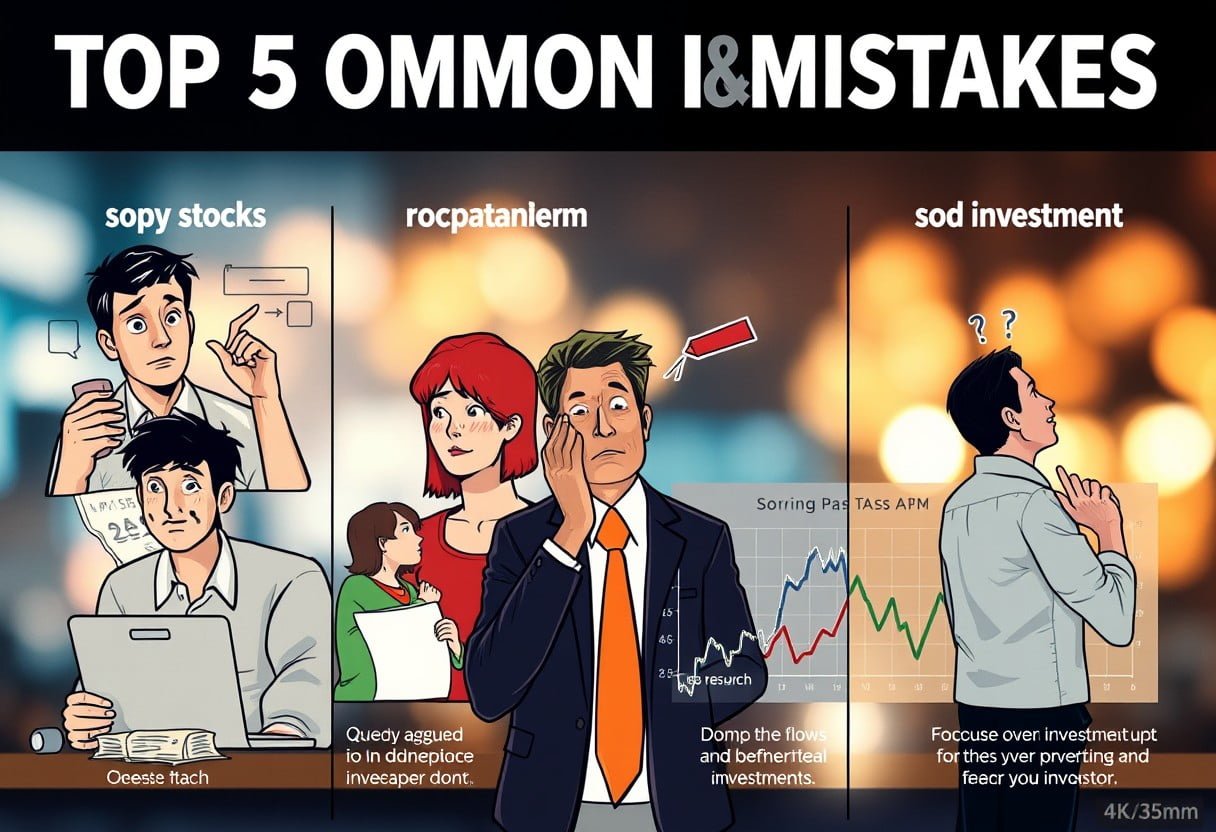The Top 5 Common Investing Mistakes And How To Avoid Them
Many investors fall prey to common pitfalls that can derail their financial success. Understanding these dangerous mistakes can help you make informed decisions and safeguard your investments. In this blog post, we will outline the top 5 investing mistakes you should watch out for and provide actionable tips on how to avoid them. By learning from others’ errors, you can create a more secure financial future. For further insights, check out The 5 Mistakes Every Investor Makes and How to Avoid ….
Key Takeaways:
- Emotional Decision-Making: Avoid making investment choices based on emotions; instead, develop a disciplined strategy to guide your decisions.
- Diversification: Ensure you diversify your portfolio to mitigate risk. Relying too heavily on a single asset or sector can lead to significant losses.
- Failing to Research: Conduct thorough research before investing. Understand the fundamentals of the assets and markets to make informed choices.
1. Diversification reduces risk and enhances portfolio stability. 2. Avoid emotional decisions; stick to your investment strategy. 3. Conduct thorough research before making investment choices. 4. Don’t chase short-term trends; focus on long-term goals. 5. Regularly review and adjust your investment portfolio. 6. Consult financial experts for informed investment decisions.
Understanding Investment Basics
Your journey into the world of investing begins with grasping the fundamental concepts that will guide your decisions. Understanding investment basics is crucial to avoiding costly mistakes and achieving your financial goals.
What is Investing?
An investment is the act of allocating resources, usually money, in order to generate income or profit over time. It involves purchasing assets that you believe will grow in value or yield returns, thereby increasing your financial wealth.
Types of Investments
An array of investment options can suit various financial goals and risk tolerances. Here’s a breakdown of some common types of investments:
| Stocks | Equities that represent ownership in companies. |
| Bonds | Debt securities issued by corporations or governments. |
| Mutual Funds | Investment vehicles pooling money from multiple investors for diversified investments. |
| Real Estate | Property investments, offering potential rental income and appreciation. |
| Commodities | Physical goods such as gold, oil, and agricultural products. |
- Stocks
- Bonds
- Mutual Funds
- Real Estate
- Commodities
Knowing the types of investments can empower your decision-making process.
An informed investor is one who understands the different types of investments and their associated risks. Each category of investment offers unique advantages and disadvantages, so it’s vital to assess your financial goals carefully before choosing where to allocate your resources. For instance:
| Risk Level | Potential Return |
| Stocks | High |
| Bonds | Moderate |
| Mutual Funds | Variable |
| Real Estate | Potentially High |
| Commodities | Highly Variable |
- Risk Level
- Potential Return
- Long-term Growth
- Liquidity
- Market Volatility
Knowing the dynamics and risks associated with each investment type can help you make smarter choices.
The Importance of Investment Education
For anyone looking to invest, education is key to navigating the financial landscape successfully. Understanding the principles of investing can significantly impact your long-term success.
Investments can be a powerful tool for building wealth, but if you lack knowledge, you might fall victim to scams or make decisions that jeopardize your financial future. By educating yourself on investment strategies, risk assessment, and market trends, you can protect your assets and grow your wealth over time. A solid investment education enables you to confidently assess opportunities and avoid common pitfalls, ensuring a more secure financial future.
Mistake #1: Impulsive Decision-Making
While the world of investing can evoke strong emotions, *impulsive decision-making* often leads to disastrous outcomes. Too many investors act on a whim, allowing their emotions to dictate their choices, rather than following a defined strategy. This chapter helps you recognize the emotional influences at play and avoid falling into this common trap.
Emotional Influences on Investing
One of the foremost challenges in investing is managing your emotions. *Fear, greed,* and *anxiety* can skew your judgment, leading you to make hasty choices. When the market fluctuates, it’s easy to react impulsively, but this often results in selling low or buying high, which undermines your financial goals.
The Dangers of Chasing Trends
Influences from social media and financial news can create a false sense of urgency, compelling you to chase after what seems to be the latest trend. This behavior might yield short-term gains, but it can jeopardize your long-term portfolio. You should avoid following trends simply because they appear popular or are talked about widely.
Investing based purely on trends can lead to significant losses. Many investors mistakenly believe that the latest rising stocks or hot sectors will continue to soar. However, such *chasing* frequently results in buying at inflated prices, only to see your investments fall once the hype dies down. Understanding when to step back from the noise is crucial for safeguarding your investments.
Strategies to Cultivate Patience
Trends in your investment behavior can be addressed and improved through patience. **Setting clear investment goals** and creating a well-defined strategy will empower you to withstand market fluctuations. By adhering to your plan and resisting impulsive actions, you can maintain your focus on long-term growth rather than short-term noise.
Patience is an necessary virtue in investing that you must cultivate. This means embracing a long-term perspective and acknowledging that market fluctuations are natural. You can enhance your investment journey by regularly reviewing your portfolio, adjusting your strategy as needed, and reminding yourself of your long-term objectives. In doing so, you’ll minimize the urge to make impulsive decisions that could jeopardize your financial future.

Mistake #2: Lack of Diversification
Many investors make the critical mistake of failing to diversify their portfolios. This oversight can lead to significant losses in volatile markets. To learn more about common pitfalls, contact Reinblatt Financial Inc. to secure a bright financial future.
What is Diversification?
Any effective investment strategy should include diversification, which involves spreading your investments across various asset classes and sectors. This approach helps mitigate risk and reduce the impact of a single investment’s poor performance on your overall portfolio.
Risks of Over-Concentration
Diversification significantly reduces your risk by avoiding over-concentration in one particular area. Relying too heavily on a single investment, such as one stock or sector, can expose you to substantial financial risks, especially during market downturns.
Plus, if that singular investment performs poorly, the consequences can be devastating for your overall financial health. This is because most portfolios are weighted so heavily towards a few assets that any negative fluctuation can lead to substantial losses. To preserve your wealth, it’s crucial to avoid this over-reliance on individual investments.
Effective Diversification Strategies
Diversification can be achieved using different investment vehicles, such as stocks, bonds, and real estate. By mixing various asset types and regularly rebalancing your portfolio, you can help create a buffer against market volatility.
Strategies should include investing in global markets, as well as considering different industries and asset types. For instance, consider index funds or ETFs that provide natural diversification, allowing you to spread your investment across numerous securities with less effort. Adopting these practices can greatly enhance your portfolio’s resilience and potential for steady growth.
Mistake #3: Neglecting Research
To succeed in investing, you must prioritize research. Understanding the fundamentals of the companies or assets you’re interested in can significantly impact your decision-making process. Without adequate due diligence, you may invest in opportunities that appear appealing but lack the necessary backing or future potential, ultimately jeopardizing your financial goals.
Importance of Due Diligence
To make informed investment decisions, it is crucial to conduct thorough due diligence. This means assessing not just the company’s performance, but also market conditions, industry trends, and potential risks. A solid understanding of these elements enables you to make choices that align with your long-term objectives.
Common Research Pitfalls
For many investors, the tendency to skip necessary research can result in costly mistakes. Often, individuals might rely too heavily on social media trends, recommendations from friends, or recent headlines without digging deeper. This superficial approach can lead to investing in overhyped stocks or missing out on sound opportunities.
Neglecting to seek credible information or to understand the underlying factors affecting an asset can be detrimental. You might fall victim to the herd mentality or act based on emotion rather than a systematic evaluation. This can lead to poor investment choices that don’t align with your overall strategy or risk tolerance.
Tools and Resources for Better Research
Any serious investor should leverage available tools and resources to enhance their research capabilities. Websites offering financial analysis, company profiles, and historical performance data are invaluable for gaining insight into potential investments.
Another effective way to improve your research is by utilizing financial news platforms, analyst reports, and forums dedicated to investment discussions. Engaging with reputable investment journals, attending webinars, and following experienced investors can also enrich your understanding and lead to more informed but cautious decisions.
Mistake #4: Setting Unrealistic Expectations
Now, many investors fall into the trap of setting unrealistic expectations when it comes to returns on their investments. This can lead to disappointment, poor decisions, and ultimately, significant losses. It’s vital to align your investment goals with the realities of the market to ensure a smoother investment journey.
Understanding Market Realities
Realities of the market dictate that returns vary widely based on factors such as economic conditions, interest rates, and global events. Understanding these dynamics can help you form a more realistic outlook, allowing you to make informed investment choices.
The Psychology of Expectation
Understanding how expectation influences your investing behavior is crucial. You may feel pressured to mimic the performance of top-tier investors or popular market trends. This can lead to **unwise decisions**, such as chasing after inflated returns or abandoning sound strategies in response to short-term market fluctuations.
Understanding your own psychological tendencies is vital. Your emotions can skew your view of investment performance, leading you to expect immediate gratification or unrealistic growth rates. By recognizing this, you can learn to temper your expectations and focus on long-term gains rather than short-term pressures.
How to Set Achievable Financial Goals
With a clear understanding of market behaviors, you can set achievable financial goals that are both motivating and realistic. Focus on historical averages and industry benchmarks to gauge what is reasonable for your investment strategy.
Expectations should embrace a balanced approach, incorporating both growth and risk management. By creating specific, measurable, and time-bound financial targets, you’ll position yourself to maintain focus and resilience, even during market volatility. This disciplined strategy will help you build wealth over time while avoiding the pitfalls of unrealistic expectations.
Mistake #5: Ignoring Fees and Taxes
Despite the potential for profitable returns, many investors make the grave mistake of ignoring fees and taxes, which can significantly erode your overall investment performance. To better inform your investing journey, check out the Tips for Avoiding the Top 20 Common Investment Mistakes: … .
Understanding Investment Fees
Ignoring the various investment fees associated with your portfolio can lead to reduced returns over time. Fees such as management fees, trading commissions, and expense ratios can add up quickly, eating into your potential gains. It’s imperative to review the fee structure of any investment product you consider.
Impact of Taxes on Returns
Impact of taxes on your investment returns can drastically affect your net profit. If you fail to account for capital gains taxes and other tax implications, your perceived gains can be significantly less when tax season rolls around. Understanding your tax bracket can help you make more informed decisions.
With proper planning, you can minimize the impact that taxes have on your returns. By utilizing tax-advantaged accounts such as Roth IRAs or 401(k)s, you can enhance your investment growth over time. Additionally, considering the implications of buying and selling investments in a taxable account can lead to more strategic decisions.
Strategies for Minimizing Costs
Fees associated with investment accounts can skyrocket if you don’t pay attention. By choosing low-cost index funds or ETFs over actively managed funds, you can reduce the fees you pay and keep more of your hard-earned money.
Strategies like negotiating fees with your financial advisor or using robo-advisors can also help minimize costs. Furthermore, being mindful of your investment frequency and opting for tax-efficient investment strategies can prove beneficial in reducing both fees and tax liabilities.
To wrap up
Hence, being aware of the top five common investing mistakes—such as emotional trading, neglecting research, over-diversification, timing the market, and failing to set clear goals—empowers you to make informed decisions. By recognizing these pitfalls and implementing strategies to avoid them, you can enhance your investment approach and work towards achieving your financial objectives more effectively. Note, successful investing is a gradual process that requires discipline and patience, and by steering clear of these common traps, you can put yourself on the path to success.
FAQ
Q: What are the top common investing mistakes that beginners often make?
A: The top common investing mistakes include: 1) Not having a clear investment strategy, which can lead to haphazard investment decisions. 2) Emotional investing, where investors react impulsively to market fluctuations instead of following a plan. 3) Failing to diversify a portfolio, resulting in increased risk. 4) Ignoring fees and expenses, which can erode overall returns. 5) Overtrading, where frequent buying and selling respond to market trends rather than fundamental analysis, can lead to increased costs and missed opportunities.
Q: How can I avoid emotional investing?
A: To avoid emotional investing, it’s vital to establish a well-defined investment plan that includes clear goals and a risk tolerance level. It helps to stick to this plan even during market volatility. Additionally, investors can employ strategies like dollar-cost averaging, which involves investing a fixed amount at regular intervals, and regularly reviewing their portfolio to stay focused on long-term objectives rather than short-term market movements. Removing oneself from daily market noise and focusing on research and analysis can also mitigate impulsive behavior.
Q: What strategies can help ensure diversification in my investment portfolio?
A: To ensure proper diversification in an investment portfolio, investors can follow these strategies: 1) Include a mix of asset classes, such as stocks, bonds, mutual funds, and real estate, to spread risk. 2) Invest across different sectors (e.g., technology, healthcare, consumer goods) to reduce the impact of poor performance in any one area. 3) Consider geographical diversification by investing in international securities as well as domestic ones. 4) Use low-cost index funds or ETFs that provide instant diversification through a single investment. Regularly reviewing and rebalancing your portfolio is also vital to maintain desired levels of diversification over time.



